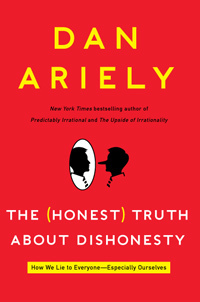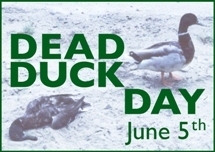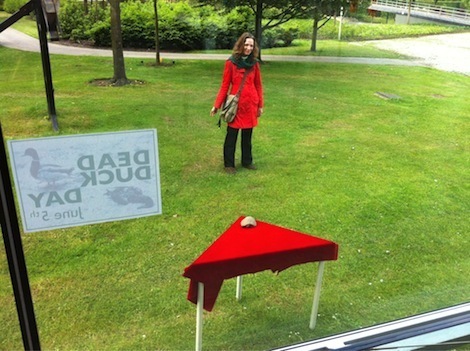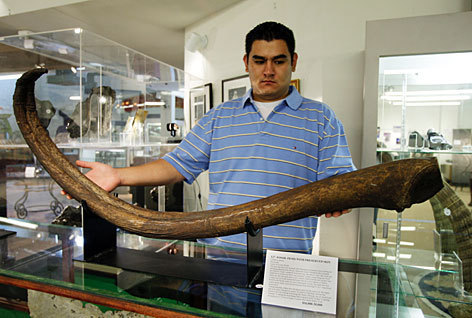Marc Abrahams's Blog, page 569
June 7, 2012
Honestly: Ig Nobel winner’s new book about dishonesty
 Ig Nobel Prize winner Dan Ariely has a new book out. It’s called The Honest Truth About Dishonesty — How We Lie to Everyone – Especially Ourselves.
Ig Nobel Prize winner Dan Ariely has a new book out. It’s called The Honest Truth About Dishonesty — How We Lie to Everyone – Especially Ourselves.
Catch him live on his book tour (which today arrives in first Cambridge, then Boston, Massachusetts)
Ariely shared (with Rebecca L. Waber, Baba Shiv and Ziv Carmon) the 2008 Ig Nobel Prize in medicine, for demonstrating that high-priced fake medicine is more effective than low-priced fake medicine.
REFERENCE for the prize-winning study: “Commercial Features of Placebo and Therapeutic Efficacy,” Rebecca L. Waber; Baba Shiv; Ziv Carmon; Dan Ariely, Journal of the American Medical Association, March 5, 2008; 299: 1016-1017.

2 million looks at sex in an MRI tube
The historic video of the video of MRI sex has gone past the 2 million (2,000,000) views mark on YouTube. Dr. Pek van Andel produced the MRI sex video as a spinoff from his historic, ultimately prize-winning experiment. The experiment asked and answered the question: Is it possible to take MRI images of a couple’s sexual organs while those organs are in use?
The Ig Nobel prize in medicine, in the year 2000, was awarded to Willibrord Weijmar Schultz, Pek van Andel, and Eduard Mooyaart of Groningen, The Netherlands, and Ida Sabelis of Amsterdam, for their report, “Magnetic Resonance Imaging of Male and Female Genitals During Coitus and Female Sexual Arousal.” [Published in British Medical Journal, vol. 319, 1999, pp 1596-1600.]
BONUS: Ida Sabelis, one of the people inside the MRI tube, later wrote about the experience. That account was published in the Annals of Improbable Research.
BONUS: Dutch filmmaker Bahram Sadeghi later made a short documentary about the people involved in the experiment. Here it is:

June 6, 2012
Things that wash up on the beach
“Flotsam & Jetsam is a documentary”, say its makers, “based around the beachcombers of Texel, one of the largest Frisian islands north of Holland. Due to Texel’s geographical position, tidal system and strong winds, an estimated two tons of Flotsam & Jetsam washes up on its beach each day. The film follows the lives of the beachcombers (or Jutters as they are known), exploring their relationships and history as extraordinary people in extraordinary situations.”
Here it is:
(Thanks to investigator Wally Drum for bringing this to our attention.)

Bacteriology: ox ox ox ROO or a Sor Rub?
Investigator Michael Strack sends word about some words:
For readers who consider biochemistry a dry discipline, the article “Rubredoxin: Oxygen Oxidoreductase Enhances Survival of Desulfovibrio vulgaris Hildenborough under Microaerophilic Conditions” provides some contrary evidence, as authors Wildschut et al. provide notable diversity and combinations of memorable abbreviations.
The action is condensed into the very first sentence of the abstract, which states “Genes for superoxide reductase (Sor), rubredoxin (Rub), and rubredoxin: oxygen oxidoreductase (Roo) are located in close proximity in the chromosome of Desulfovibrio vulgaris Hildenborough”, and continues: “Protein blots confirmed the absence of Roo from roo mutant and sor-rub-roo (srr) mutant cells”.
NB: Roo is the colloquial term for kangaroo for us antipodeans.
The study is:
“Rubredoxin: Oxygen Oxidoreductase Enhances Survival of Desulfovibrio vulgaris Hildenborough under Microaerophilic Conditions,” Janine D. Wildschut, R. Michael Lang, Johanna K. Voordouw, and Gerrit Voordouw [pictured here], Journal of Bacteriology, vol. 188 no. 17, September 2006, pp. 6253-6260.

June 5, 2012
Happy Dead-Jeremy-Bentham Day
Today is Dead Jeremy Bentham Day. The University College London [UCL] web site explains why such a day almost makes sense:
At the end of the South Cloisters of the main building of UCL stands a wooden cabinet, which has been a source of curiosity and perplexity to visitors.
The cabinet contains Bentham’s preserved skeleton, dressed in his own clothes, and surmounted by a wax head. [The photo here shows exactly that.] Bentham requested that his body be preserved in this way in his will made shortly before his death on 6 June 1832. The cabinet was moved to UCL in 1850.
Not surprisingly, this peculiar relic has given rise to numerous legends and anecdotes. One of the most commonly recounted is that the Auto-Icon regularly attends meetings of the College Council, and that it is solemnly wheeled into the Council Room to take its place among the present-day members. Its presence, it is claimed, is always recorded in the minutes with the words Jeremy Bentham – present but not voting. Another version of the story asserts that the Auto-Icon does vote, but only on occasions when the votes of the other Council members are equally split. In these cases the Auto-Icon invariably votes for the motion.
Bentham had originally intended that his head should be part of the Auto-Icon…
Other parts of the UCL site explain who Jeremy Bentham was, and what colorful things he said. This video from UCL gives an excruciatingly close, long look at Bentham’s head, what there is of it:
BONUS (possibly unrelated):

Lipstick names — a textual analysis
 Anyone who has attempted to combine the ‘Presentation of Self’ theories of Erving Goffman and the semiotic modelling methods of Roland Gérard Barthes with regard to the names of lipsticks, could well consult the work of professor Debra Merskin (of the School of Journalism and Communication at the University of Oregon, US), who has categorised the names of no less than 1,722 lipsticks.
Anyone who has attempted to combine the ‘Presentation of Self’ theories of Erving Goffman and the semiotic modelling methods of Roland Gérard Barthes with regard to the names of lipsticks, could well consult the work of professor Debra Merskin (of the School of Journalism and Communication at the University of Oregon, US), who has categorised the names of no less than 1,722 lipsticks.
“The names of lipsticks and how they penetrate women’s psyches as semiotic tools used in branding are the foci of the present study.”
The professor’s study delineated 14 name-categories for the lipsticks, and then allocated the names accordingly – the results are listed here in order of their popularity.
• Food: 24%
• Color: 20%
• Sex and Romance: 10%
• Elements and Minerals: 9%
• Emotions and Characteristics: 8%
• Other: 8%
• People and Names: 5%
• Flowers: 5%
• Places: 4%
• Objects: 3%
• Darkside: 2%
• Arts and Media: 1%
• Birds and Animals: 1%
• Times and Seasons:
Following the classification, the professor concludes that :
“When women ‘put on a face,’ or ‘put on war paint,’ they are not only acting in line with social prescriptions of feminine beauty, but are also involved in a system of meaning that helps them to navigate the sea of changing conditions that are a part of postmodern social experience.”
The paper : Truly Toffee and Raisin Hell: A Textual Analysis of Lipstick Names is published in the journal Sex Roles, Volume 56, Numbers 9-10 (2007), 591-600, and can be ‘red’, in full, here :
Notes:
• Since the survey, one of the lipsticks in the ‘Other’ category ‘But Officer’ has been withdrawn from production.
• The paper draws attention to potential shortcomings regarding the difficulties of categorising names which might fit into multiple categories e.g. ‘Rose’ - which could conceivably fit into Color, Flowers, People and names, Places, Sex and Romance, and Darkside.
• The website which was used to retrieve the index of names : www.thelipstickpage.com is now off-line.

Dead Duck Day crowds gather in Rotterdam
 With 20 minutes to go before the 2012 Dead Duck Day celebration begins, crowds gather outside the Natural History Museum in Rotterdam. This photo, below, documents the mounting excitement.
With 20 minutes to go before the 2012 Dead Duck Day celebration begins, crowds gather outside the Natural History Museum in Rotterdam. This photo, below, documents the mounting excitement.


June 4, 2012
Today is Dead Duck Day
 On June 5, 1995, at 5.55 pm, a mallard duck slammed into the window of the Natural History Museum in Rotterdam, the first big step on its journey into history. I, Kees Moeliker, the museum’s curator, subsequently published the first scientifically recorded description of homosexual necrophilia in the mallard duck (click here for PDF). The account was later honored with an Ig Nobel Prize.
On June 5, 1995, at 5.55 pm, a mallard duck slammed into the window of the Natural History Museum in Rotterdam, the first big step on its journey into history. I, Kees Moeliker, the museum’s curator, subsequently published the first scientifically recorded description of homosexual necrophilia in the mallard duck (click here for PDF). The account was later honored with an Ig Nobel Prize.
Now, every year, the duck-loving citizens of Rotterdam, gather to commemorate and re-enact the historic event. We invite you to join us — to attend and participate, today exactly at 5.55 pm, next to the Natural History Museum Rotterdam, the Netherlands. Immediately afterwards, please also take part also in the six-course duck dinner at a nearby restaurant. Click here for information in Dutch.

The growths and declines of facial hair on Londoners
 Not being a barber, and not having had an adulthood that spanned 130 years, Dwight E Robinson was in no position to report firsthand the frequency of changes in relative prevalence of sideburns, moustaches and beards in London during the years 1842-1972. He used an indirect source: issues of the Illustrated London News published during that time.
Not being a barber, and not having had an adulthood that spanned 130 years, Dwight E Robinson was in no position to report firsthand the frequency of changes in relative prevalence of sideburns, moustaches and beards in London during the years 1842-1972. He used an indirect source: issues of the Illustrated London News published during that time.
Robinson, a business professor at the University of Washington, in Seattle, gathered his findings about those findings into a study that he called Fashions in Shaving and Trimming of the Beard: The Men of the Illustrated London News, 1842-1972. It was published not in Britain but in the American Journal of Sociology, in 1976.
Robinson used and, he says, improved upon a general analytic technique pioneered by Jane Richardson and AL Kroeber, who in 1940 “measured annual fluctuations in width and length of skirts, waistlines and decolletage as ratios to women’s heights“…
So begins this week’s Improbable Research column in The Guardian.
BONUS [quasi-related]: The image here, a poster advertising an exhibition in London in May 2012, demonstrates the city’s abiding interest in the growth and decline and regrowth of facial hair.

Adam’s “rib” a Biblical euphemism
In a letter to the editor in the American Journal of Medical Genetics, two authors suggest that the story of Adam’s rib being the humble beginnings of Eve is the result of a mistranslation. In reality, they suggest, the story is an explanatory myth for why humans are one of the few mammals lacking a baculum, or penile bone.
“Congenital Human Baculum Deficiency: The Generative Bone of Genesis 2:21-23,” Scott F. Gilbert & Ziony Zevit, American Journal of Medical Genetics, May 2001, Vol. 101, pp. 284-285. The authors from Swarthmore College and American Jewish University write:
Our opinion is that Adam did not lose a rib in the creation of Eve. Any ancient Israelite (or for that matter, any American child) would be expected to know that there is an equal (and even) number of ribs in both men and women. Moreover, ribs lack any intrinsic generative capacity. We think it is far more probable that it was Adam’s baculum that was removed in order to make Eve. That would explain why human males, of all the primates and most other mammals, did not have one. The Hebrew noun translated as “rib”, tzela (tzade, lamed, ayin), can indeed mean a costal rib. It can also [...] be used to indicate a structural support beam. Interestingly, Biblical Hebrew, unlike later rabbinic Hebrew, had no technical term for the penis and referred to it through many circumlocutions. [...]
A rib has no particular potency nor is it associated mythologically or symbolically with any human gen- erative act. Needless to say, the penis has always been associated with generation, in practice, in mythology, and in the popular imagination. Therefore, the literal, metaphorical, and euphemistic use of the word tzela make the baculum a good candidate for the singular bone taken from adam to generate Eve.

The fossil baculum of an ancient walrus

Marc Abrahams's Blog
- Marc Abrahams's profile
- 14 followers
























